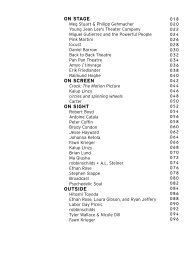BOMB Magazine: Shirin Neshat by Arthur C. Danto
BOMB Magazine: Shirin Neshat by Arthur C. Danto
BOMB Magazine: Shirin Neshat by Arthur C. Danto
Create successful ePaper yourself
Turn your PDF publications into a flip-book with our unique Google optimized e-Paper software.
with my own voice, something between breathing and singing, repeated in different<br />
time signatures. I improvised it as we were recording. In Anchorage, which was a<br />
<strong>BOMB</strong> <strong>Magazine</strong>: <strong>Shirin</strong> <strong>Neshat</strong> <strong>by</strong> <strong>Arthur</strong> C. <strong>Danto</strong> 5/17/10 1:58 PM<br />
single projection, there was a combination of chanting and a very simple song, and<br />
again, I improvised.<br />
AD You composed those songs spontaneously?<br />
SN Yes, on the spot at the recording studio.<br />
AD There must have been a moment when the ideas that began to be expressed in<br />
Turbulent came to consciousness. You took a shift, a change in direction; did you<br />
feel yourself on the threshold of something quite different? I remember seeing some<br />
photographs of you with what seemed an antique sort of rifle. Where do these fit in?<br />
SN The first group of photographic work I produced in 1993 certainly reflected the<br />
point of view of an Iranian living abroad, looking back in time and trying to analyze<br />
and comprehend the changes that had taken place in Iran since the revolution. It<br />
was the approach of an artist who had been away for a long time, and it was an<br />
important turning point for me artistically and personally, as it became more than<br />
art making but a type of journey back to my native country. I was deeply invested<br />
in understanding the ideological and philosophical ideas behind contemporary Islam,<br />
most of all the origin of the revolution and how it had transformed my country. I<br />
knew the subject was very complex and broad so I minimized my focus to<br />
something tangible and specific. I chose to concentrate on the meanings behind<br />
“martyrdom,” a concept which became the heart of the Islamic government’s<br />
mission at the time, particularly during the Iran/Iraq War. It promoted faith,<br />
self-sacrifice, rejection of the material world, and ultimately, life after death. Mostly,<br />
I was interested in how their ideas of spirituality, politics and violence were and still<br />
are so interconnected and inseparable from one another. But after a few years, I felt<br />
that I had exhausted the subject and needed to move on. I no longer wanted to<br />
make work that dealt so directly with issues of politics. I wanted to make work that<br />
was more lyrical, philosophical and poetic.<br />
AD It did come across as didactic, and, in a way, rhetorical.<br />
SN There were a lot of problems there with the issue of translation, literally in<br />
terms of the writing I was inscribing onto the photos and in cultural misreading. I<br />
must admit, when I made this group of work, I did not have an audience in mind. I<br />
had never exhibited before and had no plans for it. Eventually, when I did have an<br />
audience, I felt conflicted as to how I might go about translating ideas that were so<br />
entirely based on non-Western rationality without compromising their authenticity<br />
and meaning. Looking back at this work, I do see the problems but it was an honest<br />
attempt to reconnect and raise important issues in regard to my culture. I reduced<br />
my references in order to get a handle on the subject of martyrdom, but perhaps a<br />
lot got lost in between. I felt strongly about moving on, making work that, while<br />
ethnically specific, could allow wider interpretation.<br />
AD Something that touches on what one might call universal human nature.<br />
SN Exactly.<br />
AD That’s the feeling I have with those works.<br />
SN By this time, you have to understand, my relationship to the subject, my<br />
understanding and feelings about the revolution had all changed. When I first<br />
arrived in Iran, I was really taken <strong>by</strong> everything and desperately wanted to belong<br />
to the Iranian community again. It was almost a romantic return to Iran. Turbulent<br />
was the first work that no longer had the perspective of an artist distanced from her<br />
culture; it dealt with an issue that belonged to the present and revealed a new<br />
sense of intimacy and familiarity between myself and the subject. By this time, I<br />
had a pretty good understanding of the way in which Iranian society functioned. I<br />
had been traveling to Iran frequently and was working with an almost entirely<br />
Iranian crew.<br />
http://bombsite.com/issues/73/articles/2332 3 of 10






